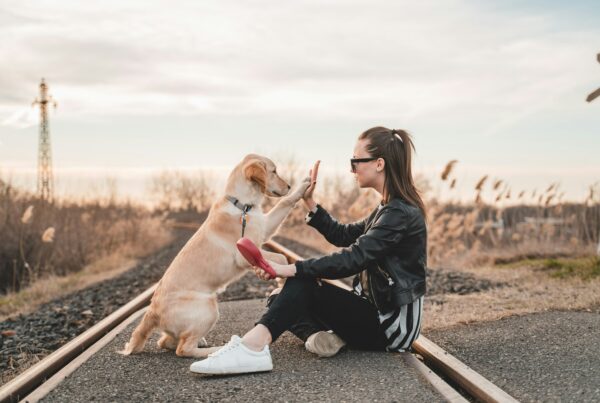We all love puppies, but as our dogs reach the other end of the continuum of life it becomes harder for us pet parents to know what to do. We want our dogs to be as happy and healthy as possible until the end, so what can we do to achieve this, and how do we assess the quality of life of our senior dogs? A good way of gauging quality of life in senior dogs is the HHHHHMM assessment, but first let’s look at how we can keep our dogs healthier and happier for longer.
Care Rather Than Cure
It is better for both our dogs and us if we take a care rather than cure approach to ensure their health and wellbeing.
First of all, regular check-ups with your vet are recommended as your dog reaches his senior years. Some older dogs visit the vets monthly, especially those with medical issues, but a good rule of thumb for an otherwise healthy older dog is “Twice for Life”, meaning a biannual check-up (every 6 months).
Most owners of older pets find this very reassuring. Having your vet confirm your furry family member is travelling well is gratifying and can really put your mind at ease.
Diet is fundamental to the health of dogs of any age, yet often overlooked by us. Considering what you’re feeding your dog is a great start in making sure their diet is healthy. Senior dogs have a dependency on a good diet as much as ever to keep their muscles and organs working as they should.
These days we have a range of supplements to boost the immunity of our dogs or address specific health conditions. No matter how old your dog is, probiotics can work wonders in ensuring your dog will make the most of their diet and absorb as much nutrition as possible to keep them healthy.
Monitoring Symptoms
When the health of our dogs begins to fail we don’t always pick up on the symptoms. They’re often easy to miss, and it’s not as if our dogs can verbalize their pain or discomfort.
Always take note of changes in the behavior of your dog. If they seem quieter, more reluctant to exercise, or have a diminished appetite, then it is worth speaking with your vet immediately.
Our vets are trained to detect early stages of health issues, and starting treatment early is often much more effective, less costly, and better for our dogs.
How to Assess Quality of Life of Senior Dogs
If the health of our dogs does deteriorate, it is important to know how we can assess their quality of life. Taking a pragmatic approach to this not only ensures our dogs are happy, but it helps us prepare for the day it’s time to say goodbye.
A good method we can use to assess the Quality of Life of our senior dogs is the HHHHHMM assessment. This stands for Happiness, Hunger, Hydration, Hygiene, Hurt, Mobility, and More good days than bad.
The HHHHHMM assessment makes it much easier for us as pet parents to consider these factors individually, or even assign a score to each one to give a numerical assessment over time.
Using this process is a very personal and individualized thing, and as well as the wellbeing of our dogs we must factor in our own wellbeing as pet parents and caregivers.
The HHHHHMM Assessment
Let’s look at the seven factors of the HHHHHMM assessment so we can understand each one individually:
- Happiness – Does your dog, when they are awake, seem to be enjoying their existence, or is there at least some purpose to that existence?
- Hunger – Does your dog have a reasonable appetite, independently, or with some help from yourself?
- Hydration – Is your dog capable of maintaining a reasonable level of hydration?
- Hygiene – Does your dog, independently or with help, manage to comfortably toilet and have a clean, dry coat for majority of their day?
- Hurt – We cannot prevent every day-to-day pain for our dogs, but we must be very careful not to let the level of ongoing pain to be unacceptably high.
- Mobility – This aspect of life should be considered along with the hygiene and hurt aspects. Is your dog’s level of mobility, alone or with help, an acceptable thing?
- More good days than bad days – This final point is self-explanatory but often difficult to answer. Does your dog have more good days than bad?
The HHHHHMM assessment is a very useful, simple guide to looking at the quality of life of our senior dogs, but you may also benefit from speaking to your vet about a geriatric care plan tailored to you and your dog.
Frank, repeated, and careful communication between yourself and your veterinarian is highly recommended.
When It’s Time to Say Goodbye
Despite this being the hardest period we share with our dogs, we should try our best not to put their care into the too hard basket. Often some simple medications, environmental modifications, and simple regular nursing-type care can make all the difference. We should rest-assured our dogs can receive the medication they need to keep them relatively pain-free until the end. As pet parents we can only do our best, and we should always appreciate the love they have brought to our lives. Eventually however, the unavoidable cannot be avoided any longer. The ability to give ailing pets the marvelous gift of euthanasia is a great privilege.
Photo credit: https://unsplash.com/photos/0fwGlFeEYB8
Love our content? Share it with a friend or link it to social media. Like short clips of cute household pets? Training tips? Follow us on instagram @nydognanny or on YouTube at nydognanny. Have some news you needs to get to dog and cat parents stat? Email info@newyorkdognanny.com with your article pitch.




